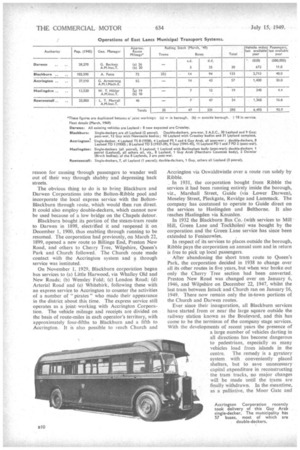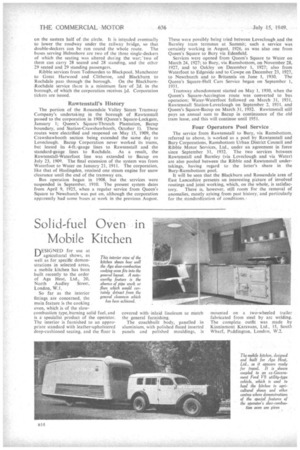Close-knit Services Coy East Lancs
Page 18

Page 20

Page 21

Page 22

If you've noticed an error in this article please click here to report it so we can fix it.
Since the Days of Steam Tram: Group of Municipalities has Won Together and• Inter-running thms Continues
IN East Lancashire there is a group of municipal passenger undertakings which has been knit together since the days of steam trams. When electrification took place the systems formed a district group, as they chose the 4-ft. gauge, whilst all the undertakings south of them decided on the standard 4 ft. 8i ins. The undertakings are those of the corporations of Darwen, Blackburn, Accrington, Haslingden and Rawtenstall.
Until 1930 it was possible to drive a tram 21 miles, without reversing, from Bacup Market Place to Darwen Cemetery and, in fact, 40 years ago Blackburn Corporation's open-top cars were frequently hired by Sunday schools in the Rossendate Valley to convey children on " treats " to Sunnyhurst Woods, a beauty spot in Darwen. The comparative figures contained in the table on page 634 give some idea of the size of the undertakings; it should be mentioned that in each case the population of the borough has fallen substantially. since the beginning of the century.
• Undertakings Date Back 70 Years
The steam tramways from which the present undertakings derive were those of the Blackburn and Over Darwen Tramways Co. and the Rossendaie Valley Steam Tramway Co. The former was established by Act of 1879 and started a service between Blackburn and Darwen in April, 1881. The portion in Darwen was purchased by the town council in 1899 and electrified, being reopened for service on October 16, 1900. A branch up an extremely steep hill to Haddlesden, opened on October 11, 1901, completed the system. The Haddlesden route was converted to bus operation after October 13, 1937, but the main line remained until October 5, 1946, except that the portion south of Darwen Circus to Whitebait was abandoned on March 31, 1940.
Motorbus services were started to Bold Venture Park, Chapels, Spring Vale and Sunnyhurst on September 23, 1926, and later to Tockholes. The abandonment of the last of the Darwen trains would have meant the breaking of the through service between Darwen and Blackburn, as Blackburn has not yet converted its part of the route, but a joint limited-stop bus service was started. This runs every 15 minutes, except before 11.45 a.m. on Monday, Tuesday, Thursday and Friday, when the headway is 30 minutes. On Sundays the service begins at 1_15. p.m The only fares are ordinary, 5d. single, 9d. return; child, 3d. single, 5d.. return; and student,
7d. return. Mileage and receipts are divided equally between the two parties.
The working of such a service presents no great difficulty, but it is different when one comes to consider the possibility of reinstating a through stopping service over the whole of the old tram route from Whitehall to Blackburn Station, with through bookings. To appreciate this, one has only to note from the accompanying table the varying conditions under which tickets are issued.
In addition to the service provided by Darwen Corporation, there are others entering the town run either by Ribble Motor Services, Ltd., or by Ribble and Bolton Corporation jointly, without Darwen's participation. From Whitehall to the Circus the other operators' fares are id. above the local corporation's, but elsewhere they are the same.
The Bolton-Blackburn through service does not use the main road between Darwen Circus and Ewood, but travels over the circuitous and twisty Chapels route. This is a bad example of the old days of isolation, when Darwen evidently thought it necessary to protect its tram route. Now that the principle of an express service along ..the. main, road.. between Darwen and Blackburn has been acknowledged, there seems to.heno
reason for causing through passengers to wander well out of their way through shabby and depressing back streets.
The obvious thing to do is to bring Blackburn and Darwen Corporations into the Bolton-Ribble pool and incorporate the local express service with the BoltonBlackburn through route, which would then run direct. It could also employ double-deckers, which cannot now be used because of a low bridge on the Chapels detour.
Blackburn bought its portion of the steam-tram route to Darwen in 1898, electrified it and reopened it on December 1, 1900, thus enabling through running to be resumed. The corporation had previously, on March 22, 1899, opened a new route to Billinge End, Preston New Road, and others to Cherry Tree, Wilpshire, Queen's Park and Church followed. The Church route made contact with the Accrington system and a through service was instituted.
On November 1, 1929, Blackburn corporation began bus services to (a) Little Harwood, via Whalley Old and New Roads; (b) Wensley Fold; (c) London Road; (d) Arterial Road and (e) Whitebirk, following these with an express service to Accrington to counter the activities of a number of " pirates " who made their appearance in the district about this time. The express service still operates as a jointworking with Accrington Corporation. The vehicle mileage and receipts are divided on the basis of route-miles in each operator's territory, with approximately four-fifths to Blackburn and a fifth to Accrington. It is also possible to reach Church and Accrington via Oswaldtwistle Over a route run solely by Ribble.
In 1931, the corporation bought from Ribble the services it had been running entirely inside the borough, viz., Marshall Street, Guide (via Lower Darwen), Moseley Street, Pleckgate, Revidge and Lammack. The company has continued to operate to Guide direct on the services to Haslingden and Beithorne. It also reaches Haslingden via Knuzden.
In 1932 the Blackburn Bus Co. (with services to Mill Hill, Green Lane and Tockholes) was bought by the corporation and the Green Lane service has since been extended to Feniscowles.
In respect of its services to places outside the borough, Ribble Pays the corporation an annual sum and in return is free to pick up local passengers.
After abandoning the short tram route to Queen's Park, the corporation decided in 1938 to change over all its other routes in five years, but when war broke out only the Cherry • Tree section had been converted. Preston New Road was changed over on January 6, 1946, and Wilpshire on December 22, 1947, whilst the last tram between Intack and Church ran on January-16, 1949. There now remain only the in-town portions of the Church and Darwen routes.
Ever since their inauguration, all Blackburn services have started from or near the large square outside the railway station known as the Boulevard, and this has come to be the terminus of the company stage services. With the developments of recent years the presence of a large number of vehicles darting in all directions has become dangerous to pedestrians, especially as many vehicles load from islands in the centre. The remedy is a gyratory system with conveniently placed shelters, but to save unnecessary capital expenditure in reconstructing the tram tracks, no major changes will be made until the trams are • finally withdrawn. In the meantime, as a palliative, the Moor Gate and
Accrington Corporation recently took delivery of this Guy Arab single-decker. The municipality has 57 buses, most of which are double-deckers.
Lammack and the Feniscowles and Shadsworth services respectively have been joined to make cross-town routes.
The curiously named Accrington Corporation Steam Tramway Co. began services on April 8, 1886. After the statutory 21 years, Accrington Corporation exercised its right of purchase as from August 1, 1907, and next day electric cars started on the route to Oswaldtwistle via Church. The Clayton-le-Moors route was opened on September 20, 1907, Huncoat on October 26 and Baxenden on January 1, 1908. The last-named was extended in the same year over Haslingden Corporation's lines to Rawtenstall. Buses were first employed on November 1, 1928, when the Fluncoat trams were taken off. The through service to Rawtenstall was converted on May 1, 1930, OssValdtwistle on August 26, 1931, and Church in February, 1932.
Reference has been made to the appearance of independent bus proprietors in the twenties; .prominent among these was the Rishton and Antley Motor Co., of Church, which developed services from Blackburn to Accrington. via Oswaldtwistle; Great Harwood, via Oswaldtwistle, Church and Clayton; Clayton via Rishton, and Great Harwood via Rishton. Ribble, having bought the K.C.R. and Pendle services operating to the north-east of Blackburn, came into competition with the Rishton and Antiey company and eventually bought that business. Accrington Corporation then bought from Ribble two local ex-R. and A. services in the Willows Lane area. These are now worked solely by the corporation, but the following are jointly operated by Ribble and Accrington:
231-Accrington-Clitheroe, via Great Harwood.
241, 251-Accrington-Clitheroe direct.
277--Oswaldtwistle (Britannia)-Great Harwood via Church and Clayton.
267-Oswaldtwistle (Spread Eagle Street)-Clitheroe via Church and Clayton.
264-Accrington-Burnley.
For each of these three groups of routes schedules are arranged so that as nearly as possible each operator's foreign" mileage balances, then the three groups as a whole are balanced.
For the Clitheroe-Manchester express service, Ribble pays to the corporation 25 per cent, of the revenue taken in the municipal area.
Varied Conditions Cause Difficulties
The joint working with Ribble once again brings out the difficulties that arise because of varying conditions. For instance, on the joint services children over three years of age have to be paid for, but on the corporation's own service they are carried free up to five years. There are also differences of practice with workpeople's tickets. With regard to workers' fares, Accrington and other Lancashire
municipalities still have Id. returns. Surely there is no justification for such a fare in these days!' In fact, when one studies fare tables closely, one can see hundreds of uneconomic fares of this character which might well be eliminated before any general advance in fares is made to meet rising costs.
When the through service from Accrington to Bacup (broken during the war) was restored in August, 1948, difficulties over differing conditions made through booking impossible. For division of receipts, therefore, the mileage run by each of the three parties (Accrington, Haslingden and Rawtenstall) in the Accrington-Rawtenstall section only is first balanced. Rawtenstall takes all receipts on the Rawtenstall-Bacup section and, for each mile run by the other parties in that section, runs off the equivalent in the Accrington-Rawtenstall section. For the basic service from Accrington to Bacup, Rawtenstall provides six buses, Haslingden three and Accrington two.
Accrington has trolleybus powers, but is unlikely to exercise them.
Owned Trams, But Did Not Work Them Although Haslingden Corporation took over and electrified the tramways in the borough in 1908, it never worked them. It did, however, possess one piece of rolling stock, as after electrification it kept one of the old steam engines and used it when necessary for snow clearance. The through electric service was run by Accrington and Rawtenstall Corporations and three Accrington cars were stabled in John Street, Haslingden. Haslingden Corporation took the net receipts in the borough after deduction of an agreed sum -per mile by the operators. It must have been quite exciting in those days to see the non-stop tram fly past on Saturdays. This vehicle, usually decorated with flags, left Haslingden at noon and did the five-mile journey to Accrington Station in 20 minutes, so that the weary mill executives could:catch their week-end express to St. Anne's.
In 1907, Haslingden experimented with a bus service to Helnishore. The vehicle used was a Leyland single-decker. In its first five months the service carried 31,000 passengers and in the year ended March 31, 1909, 65.000 people. It was then discontinued and no further experiment was made until November 6, 1920, When a B.S.A. with a locally made 12-seater body was put to work on the same route. It was followed by an Austin. also with a local body, and then by a Cruy, On December 3, 1928, the corporations concerned initiated a limited-stop service over the tram route from Accrington to Bacup, and Haslingden bought a Leyland single-decker to participate in it. As already noted, trams were replaced on May 1, 1930, and Haslingden took its full place in the local arrangements. The problem of vehicle replacement presses, perhaps, more hardly on a small undertaking than on one with hundreds of buses. The present Haslingden fleet averages 11 years old, but the single-deckers are about 18 years old. One new single-decker was delivered in April and two more are due this month (these will all be Leyland oilers with Burlingham bodies), but the next new vehicles (two Leyland doubledeckers) are not expected before 1951.
Some difficulty has been experienced recently with the Helmshore route, where greater capacity is neede4. The route is a circular one, but the presence of a lot, bridge means that only single-deckers can be used for the full journey. Two such vehicles are employed and the service is strengthened by a double-decker working a shuttle service
on the eastern half of the circle. It is intended eventually to lower the roadway under the railway bridge, so that double-deckers can be run round the whole route. The buses serving Helmshore are two of the three single-deckers of which the seating was altered during the war;'two of them can carry 28 seated and 28 standing, and the othcr 29 seated and 29 standing passengers.
Ribble services from Todrnorden to Blackpool, Manchester to Great Harwood and Clitheroe, and Blackburn to Rochdale pass through the borough. On the Blackburn
Rochdale service thtre is a minimum fare. of 2d. in the•borough, of which the corporation receives id. Corporation tickets are issued.
Rawtenstall's History
The portion of the Rossendale Valley Steam Tramway Company's undertaking in the borough of Rawtenstall 'passed to the corporation in 1908 (Queen's Square-Lockgate, January 1; Queen's Square-Thrutch Plantation, Bacup boundary, and Station-Crawshawbooth, October 1). These routes were electrified and reopened on May 15, 1909, the Crawshawbooth section being extended the same day to Loveclough. Bacup Corporation never worked its trams, but leased its 4-ft.-gauge lines to Rawtenstall and the standard-gauge lines to Rochdale. As a result, the Rawtenstall-Waterfoot line was extended to Bacup on July 23, 1909. The final extension of the system was from Waterfoot to Water on January 21, 1911. The corporation, like that of Haslingden, retained one steam engine for snow clearance until the end of the tramway era.
Bus operation began in 1908. but the services were suspended in September, 1910. The present system dates from April 9, 1925, when a regular service from Queen's Square to Newchureb was put on, although the corporation apparently had some buses at work in the previous August.
These were possibly being tried between Loveclougkand the Burnley tram terminus at Summit; such a service was certainly working in August, 1926, as was also one from Queen's Square to Bury via Edenfield.
Services were opened from Queen's Square to Water on March 24, 1927; to Bury, via Ramsbottom, on November 28, 1927, and to Oakley on December 1, 1927; also from Waterfoot to Edgeside and to Cowpe on December 23, 1927, to Newchurch and to Britannia on June 1, 1930. The Queen's Square-Hall Cars Service began on September 1, 1931.
Tramway abandonment started on May 1, 1930, when the Queen's Square-Accrington route was converted to bus operation; Water-Waterfoot followed on March 31, 1931, Rawtenstall Station-Loveclough on September 2, 1931, and Queen's Square-Bacup on March 31, 1932. Rawtenstall still pays an annual sum to Bacup in continuance of the old tram lease, and this will continue until 1951.
Four Operators Pool Service
The service from Rawtenstall to Bury, via Rarnsbottom, referred to above, is worked as a pool by Rawtenstall and Bury Corporations, Rainsbottorn Urban District Council and Ribble Motor Services, Ltd., under an agreement in force since September 31, 1932. The two services between Rawtenstall and Burnley (via Loveclough and via Water) are also pooled between the Ribble and Rawtenstall undertakings, having regard to the latter's share in the Bury-Ramsbottorn pool. It will be seen that the Blackburn and Rossendale area of East Lancashire presents an interesting picture of involved routings and joint working, which, on the whole, is satisfac tory. There is, however, still room for the removal of anomalies, mostly arising from past history, and particularly for the standardization of conditions..


























